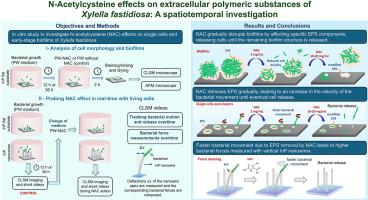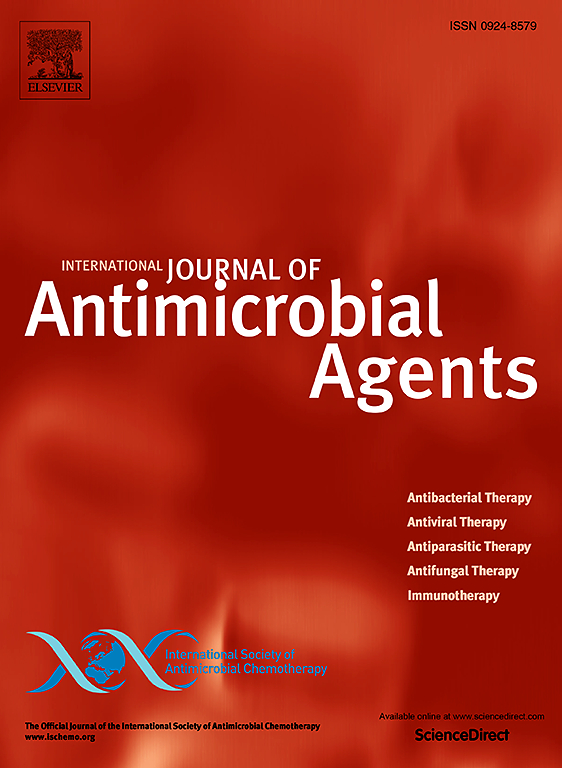N-Acetylcysteine 对 Xylella fastidiosa 细胞外聚合物质的影响:时空研究及其对生物膜破坏的影响。
IF 4.9
2区 医学
Q1 INFECTIOUS DISEASES
International Journal of Antimicrobial Agents
Pub Date : 2024-09-17
DOI:10.1016/j.ijantimicag.2024.107340
引用次数: 0
摘要
生物膜中存在的胞外高分子物质(EPS)基质大大加剧了细菌感染问题,保护细菌免受抗菌治疗,并最终导致细菌产生抗药性。因此,显然需要能破坏 EPS 基质的替代治疗方法。N- 乙酰半胱氨酸(NAC)是一种能对细菌产生多种作用的选择;然而,NAC 在生物膜中的不同作用机制仍有待阐明。在这项工作中,我们进行了微米和纳米尺度的显微镜研究,以探讨 NAC 在单细胞水平和 Xylella fastidiosa 植物病原体早期生物膜中的作用。我们展示了 NAC 对粘附表面和不同类型 EPS 的物理效应,以及单个细菌对 2 至 20 mg/mL NAC 浓度的机械响应。NAC 改变了基质上的调节膜,分解了可溶性 EPS,导致附着细菌释放,减少了松散结合 EPS 的体积,并破坏了生物膜基质。尽管没有确凿证据表明 EPS 被清除,但紧密结合的 EPS 结构发生了改变。此外,在使用 InP 纳米线阵列进行 NAC 作用时的细菌力测量结果表明,由于 EPS 被清除,细胞流动性增加,因此纳米线的动量传递增强。我们的研究结果清楚地表明,调节膜和可溶性 EPS 在细胞粘附控制中起着关键作用,而 NAC 改变了 EPS 的结构,从而提供了确凿的证据,证明 NAC 在单细胞和生物膜水平上的作用主要是去除 EPS。本文章由计算机程序翻译,如有差异,请以英文原文为准。

N-acetylcysteine effects on extracellular polymeric substances of Xylella fastidiosa: A spatiotemporal investigation with implications for biofilm disruption
Background
The matrix of extracellular polymeric substances (EPS) present in biofilms greatly amplifies the problem of bacterial infections, protecting bacteria against antimicrobial treatments and eventually leading to bacterial resistance. The need for alternative treatments that destroy the EPS matrix becomes evident. N-acetylcysteine (NAC) is one option that presents diverse effects against bacteria; however, the different mechanisms of action of NAC in biofilms have yet to be elucidated.
Objectives
In this work, we performed microscopy studies at micro and nano scales to address the effects of NAC at single cell level and early-stage biofilms of the Xylella fastidiosa phytopathogen.
Methods
We show the physical effects of NAC on the adhesion surface and the different types of EPS, as well as the mechanical response of individual bacteria to NAC concentrations between 2 and 20 mg/mL.
Results
NAC modified the conditioning film on the substrate, broke down the soluble EPS, resulting in the release of adherent bacteria, decreased the volume of loosely bound EPS, and disrupted the biofilm matrix. Tightly bound EPS suffered structural alterations despite no solid evidence of its removal. In addition, bacterial force measurements upon NAC action performed with InP nanowire arrays showed an enhanced momentum transfer to the nanowires due to increased cell mobility resulting from EPS removal.
Conclusions
Our results clearly show that conditioning film and soluble EPS play a key role in cell adhesion control and that NAC alters EPS structure, providing solid evidence that NAC actuates mainly on EPS removal, both at single cell and biofilm levels.
求助全文
通过发布文献求助,成功后即可免费获取论文全文。
去求助
来源期刊
CiteScore
21.60
自引率
0.90%
发文量
176
审稿时长
36 days
期刊介绍:
The International Journal of Antimicrobial Agents is a peer-reviewed publication offering comprehensive and current reference information on the physical, pharmacological, in vitro, and clinical properties of individual antimicrobial agents, covering antiviral, antiparasitic, antibacterial, and antifungal agents. The journal not only communicates new trends and developments through authoritative review articles but also addresses the critical issue of antimicrobial resistance, both in hospital and community settings. Published content includes solicited reviews by leading experts and high-quality original research papers in the specified fields.

 求助内容:
求助内容: 应助结果提醒方式:
应助结果提醒方式:


